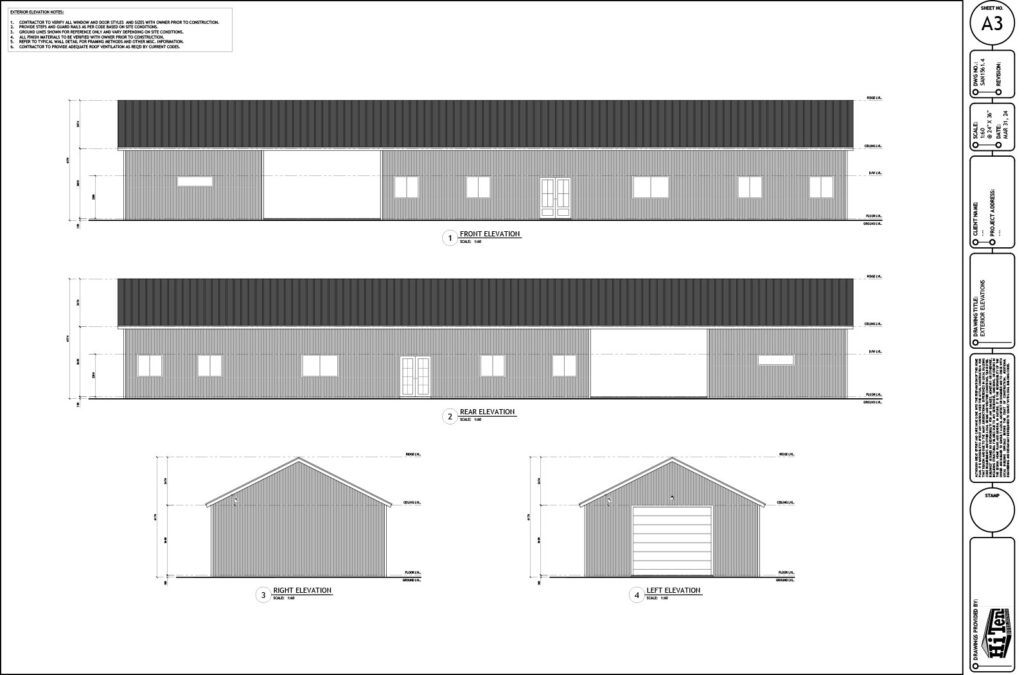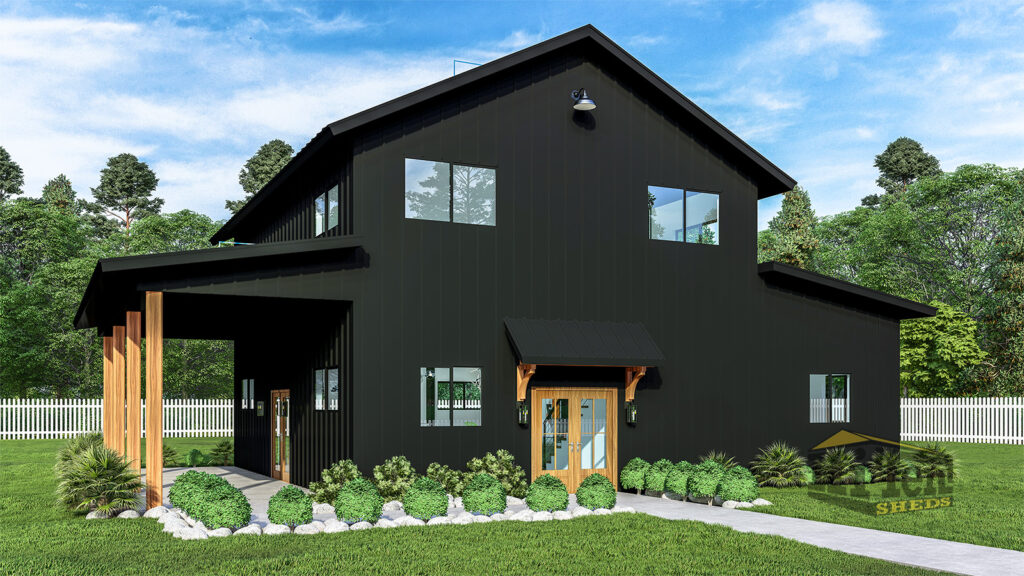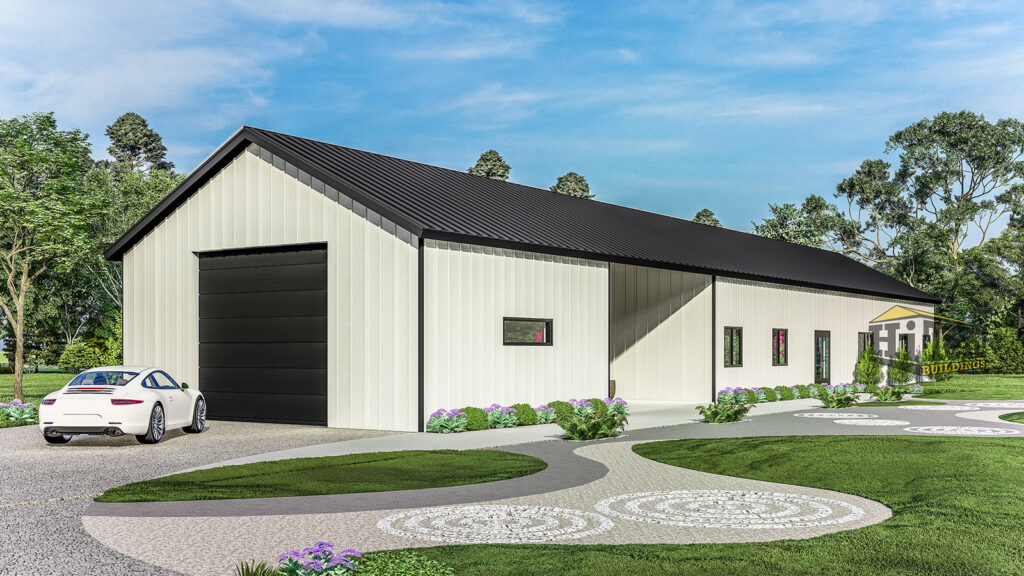Class 1a vs Class 10a Shed Homes: What You Need to Know Before Building
You’re researching shed homes online and you keep seeing two terms: Class 1a and Class 10a. Some builders advertise “residential shed homes,” others sell “sheds suitable for living,” and the price differences are massive—sometimes $50,000 or more for what looks like the same building.
So what’s the difference, and why does it matter?
The short answer: Class 1a buildings are certified residential homes. Class 10a buildings are sheds. The classification determines everything from council approval to insurance, resale value, and whether you can legally live in it.
If you’re planning to build a shed home on acreage—whether you call it a shouse, barndominium, or residential shed—understanding this distinction will save you tens of thousands of dollars and years of headaches.
What Is the Building Classification System?
Australia’s National Construction Code (NCC) classifies all buildings by their intended use. This determines which engineering standards, fire safety requirements, energy efficiency ratings, and construction methods apply.
The two classifications that matter for shed homes are:
Class 1a: Detached houses. Single dwellings being a detached house, or one or more attached dwellings, each being a building, separated by a fire-resisting wall.
Class 10a: Non-habitable buildings, including private garages, carports, sheds, and the like.
Notice the key word: “non-habitable.” Class 10a buildings are not designed, engineered, or approved for people to live in full-time.
The Critical Differences: Class 1a vs Class 10a
Let’s break down exactly what changes between these two classifications:
1. Structural Engineering Standards
Class 1a (Residential):
- Wall deflection limited to span/250 maximum
- Stricter wind load calculations for residential safety
- Higher structural integrity requirements
- Must meet residential building codes for long-term occupancy
- Engineered for furniture loads, internal wall loads, and residential use patterns
Class 10a (Shed):
- Wall deflection allowed up to span/150
- Basic wind load calculations for storage buildings
- Lower structural requirements suitable for storage, not living
- Not engineered for residential loads or occupancy
Why this matters: Class 10a buildings can flex and move more than residential buildings. That’s fine for storing tools or cars, but not ideal when you’re trying to sleep, hang pictures, or install kitchen cabinets. Over time, excessive movement causes cracking, door misalignment, and structural issues.
2. Insulation and Energy Efficiency
Class 1a (Residential):
- Must achieve minimum 7-star energy rating
- Requires proper wall, ceiling, and floor insulation
- Thermal performance calculations mandatory
- Designed for year-round comfort and energy efficiency
- Must include proper ventilation and condensation management
Class 10a (Shed):
- No energy rating required
- Insulation optional (and often minimal if included)
- No thermal performance standards
- Not designed for climate control or comfort
Why this matters: Living in a Class 10a shed without proper insulation means sweltering summers and freezing winters. Your energy bills will be astronomical trying to heat or cool an uninsulated steel building. Many people who convert Class 10a sheds to living spaces spend $15,000-$50,000 retrofitting proper insulation—money that should have been spent on Class 1a construction from the start.
3. Council Approval and Certification
Class 1a (Residential):
- Approved as a residential dwelling
- Requires full development application (DA) or complying development certificate (CDC)
- Must meet all residential building codes and local planning requirements
- Occupancy certificate issued upon completion
- Legal to live in full-time from day one
Class 10a (Shed):
- Approved as a non-habitable outbuilding
- Often exempt from DA or requires only basic approval
- Cannot be legally occupied as a residence
- No occupancy certificate (because it’s not for living)
- Converting to residential later requires full re-approval—often impossible
Why this matters: Many people buy a Class 10a shed thinking they’ll “just live in it” without telling the council. This is illegal. If council discovers you’re living in a Class 10a building, they can issue compliance orders, fines, and force you to vacate. You cannot simply retrofit a Class 10a shed to Class 1a after construction—the engineering, approvals, and construction methods are fundamentally different.
4. Insurance
Class 1a (Residential):
- Standard home and contents insurance available
- Treated as a residential dwelling by all insurers
- Full coverage for structure, contents, and liability
- No issues with claims or coverage disputes
Class 10a (Shed):
- Cannot get residential home insurance (it’s not a home)
- Shed insurance covers the structure only, not contents or liability for occupants
- If you’re living in it and make a claim, insurers may deny coverage (you’re using the building contrary to its approved purpose)
- Some insurers refuse to cover Class 10a buildings used as residences at any price
Why this matters: Imagine a bushfire destroys your Class 10a “shed home.” Your insurance company investigates and discovers you were living in a non-habitable building. They deny your claim. You lose everything—the building, your contents, and you’re still liable for the land loan. This isn’t theoretical; it happens regularly.
5. Finance and Lending
Class 1a (Residential):
- Qualifies for standard residential home loans
- Banks value it as a residential dwelling
- Can use equity for refinancing or future borrowing
- Treated as a house for lending purposes
Class 10a (Shed):
- Does not qualify for residential home loans
- Banks may offer personal loans or construction loans, but at higher interest rates
- Valued as an outbuilding, not a residence (minimal equity value)
- Refinancing or selling is extremely difficult
Why this matters: If you’re planning to finance your build, most banks won’t lend for a Class 10a shed conversion. Those that do charge higher rates and require larger deposits. When you try to sell, buyers can’t get standard home loans, which dramatically reduces your buyer pool and property value.
6. Resale Value
Class 1a (Residential):
- Valued as a residential dwelling
- Comparable sales based on other homes in the area
- Buyers can secure standard home loans
- Full market value as a house
Class 10a (Shed):
- Valued as land + outbuilding
- No residential value (it’s legally a shed)
- Buyers must pay cash or secure difficult financing
- Dramatically reduced market value
Why this matters: You might spend $300,000 building a beautiful Class 10a shed with full fitout, but when you sell, it’s valued as a $50,000 shed on land. Banks won’t lend against it as a residence, so your buyer pool is limited to cash buyers. You lose $100,000-$200,000 in value compared to a Class 1a build.
The “Grey Area” Myth: Can You Convert Class 10a to Class 1a Later?
This is the most common misconception we hear: “I’ll build a Class 10a shed now to save money, then convert it to Class 1a later when I have more budget.”
The reality: This is extremely difficult, often impossible, and usually more expensive than building Class 1a from the start.
Here’s why:
- Engineering is different: Class 1a requires stricter structural engineering. You can’t just add insulation and call it residential—the frame itself must meet residential standards.
- Council approval: Converting a Class 10a to Class 1a requires a full development application as if you’re building a new house. Many councils will reject this outright because the building wasn’t designed or engineered for residential use.
- Retrospective compliance: You’ll need to prove the existing structure meets Class 1a standards. This often requires expensive engineering assessments, and if the structure doesn’t comply, you’re looking at major structural modifications or complete rebuild.
- Cost: Retrofitting insulation, upgrading structural elements, and going through approvals often costs $50,000-$100,000+—more than the initial savings from building Class 10a.
Some councils explicitly prohibit converting Class 10a sheds to residential use. Others make it so difficult and expensive that it’s not worth attempting.
When Is Class 10a Appropriate?
Class 10a sheds are perfect for their intended purpose: storage, workshops, garages, and hobby spaces.
Build Class 10a when you want:
- A workshop or garage separate from your house
- Storage for vehicles, tools, equipment, or farm machinery
- A hobby space (woodworking, metalworking, pottery, etc.)
- An outbuilding on a property that already has a Class 1a residence
Over 50% of our Class 1a shouse buyers also purchase a matching Class 10a shed. This is the ideal combination: a certified residential home (Class 1a) plus a separate workshop/storage shed (Class 10a).
But if your intention is to LIVE in the building full-time, you need Class 1a. No exceptions, no shortcuts, no “grey areas.”
Why Some Builders Push Class 10a for Residential Use
If Class 10a is clearly not suitable for residential living, why do some builders advertise “liveable sheds” or “shed homes” using Class 10a construction?
Several reasons:
- Lower cost = easier sale: Class 10a is cheaper to build. Buyers see the lower price and don’t understand the long-term implications.
- Faster approval: Class 10a often has simpler approval processes, so builders can start faster.
- Less engineering required: Class 10a engineering is simpler and cheaper for the builder.
- Buyer ignorance: Many buyers don’t know the difference until it’s too late.
- Plausible deniability: Builders can say “we sold you a shed, what you do with it is your business” when council or insurance issues arise.
Reputable builders who specialize in residential shed homes will ONLY offer Class 1a construction for buildings intended as residences. If a builder is pushing Class 10a for a home, that’s a massive red flag.
What About “Habitable Class 10a” or “Residential-Spec Class 10a”?
Some builders advertise “residential-spec Class 10a” or “habitable Class 10a” sheds. This is marketing language, not a real classification.
There is no such thing as “habitable Class 10a” in the National Construction Code. A building is either:
- Class 1a (residential, habitable), or
- Class 10a (non-habitable shed)
A builder might add insulation, plumbing, and electrical to a Class 10a shed and call it “residential-spec,” but that doesn’t change its legal classification. It’s still a Class 10a shed. You still can’t legally live in it, insure it as a home, or finance it as a residence.
How to Verify Your Build Is Class 1a
If you’re purchasing a shed home, here’s how to confirm it’s truly Class 1a:
- Check the engineering certification: Your structural engineer’s drawings should clearly state “Class 1a residential building” in the title block and specifications.
- Review the development application: The DA or CDC should describe the building as a “Class 1a dwelling” or “residential building,” not a “shed” or “Class 10a structure.”
- Confirm energy rating: Class 1a requires a minimum 7-star energy rating certificate. If there’s no energy rating, it’s not Class 1a.
- Check the occupancy certificate: Upon completion, you should receive an occupancy certificate (OC) or certificate of classification stating the building is approved for residential occupancy. Class 10a buildings don’t get occupancy certificates.
- Ask your builder directly: “Is this engineered and approved as Class 1a residential, or Class 10a?” If they hedge, avoid vague language, or say “it’s residential-spec Class 10a,” walk away.
The Cost Difference: Is Class 1a Worth It?
Class 1a construction typically costs 10-20% more than equivalent Class 10a construction. On a $200,000 build, that’s $20,000-$40,000 extra.
Is it worth it?
Absolutely, if you’re planning to live in the building. Here’s why:
What you get for that extra 10-20%:
- Legal residential approval (no risk of council fines or eviction)
- Proper insulation and energy efficiency (saving $2,000-$5,000/year on energy bills)
- Standard home insurance (protecting your $200k+ investment)
- Residential home loan eligibility (lower interest rates, better terms)
- Full resale value as a home (potentially $100k-$200k higher sale price)
- Structural integrity for long-term living (no cracking, movement, or durability issues)
What you risk by choosing Class 10a to save 10-20%:
- Council compliance orders and fines ($10,000-$50,000+)
- Insurance claim denials (losing your entire investment)
- Inability to sell or refinance (trapped in an unsellable asset)
- Uncomfortable living conditions (extreme temperatures, high energy bills)
- Structural problems over time (cracking, movement, deterioration)
The math is clear: spending an extra $30,000 on Class 1a construction protects a $300,000+ investment and saves you tens of thousands in energy costs, insurance, and resale value over the building’s lifetime.
Real-World Example: The Cost of Getting It Wrong
We’ve spoken with dozens of people who built or bought Class 10a “shed homes” and regretted it. Here’s a typical story:
John and Sarah bought a 200m² “residential shed” for $180,000. It looked beautiful—full kitchen, bathrooms, bedrooms, the works. The builder said it was “built to residential standards” but it was approved as Class 10a to “save on council fees.”
Three years later:
- Council discovered they were living in a Class 10a building and issued a compliance order. They faced $20,000 in fines and were given 90 days to vacate or obtain residential approval.
- They applied to convert to Class 1a. Council rejected the application because the building didn’t meet residential engineering standards.
- They tried to sell. No buyers could get finance. They eventually sold for $120,000—a $60,000 loss, plus the $20,000 in fines.
- Total cost of choosing Class 10a to “save money”: $80,000+ and three years of stress.
If they’d built Class 1a from the start, they would have spent an extra $25,000-$35,000 but avoided all of these problems.
Our Approach: Class 1a Only for Residential Builds
At Shed Homes, we only build Class 1a residential shouses for buildings intended as homes. We don’t offer “residential-spec Class 10a” or any grey-area solutions.
Here’s what every Class 1a build includes:
- Full residential engineering: Structural engineering to Class 1a standards, site-specific for wind, bushfire, and soil conditions.
- Energy certification: Minimum 6-star energy rating with proper insulation and thermal performance.
- Residential approval: Development application or complying development certificate for Class 1a residential dwelling.
- Occupancy certificate: Upon completion, you receive an OC confirming residential approval.
- Insurance-ready: Full documentation for standard home and contents insurance.
- Finance-friendly: Banks treat our Class 1a builds as residential dwellings for lending purposes.
We also offer Class 10a sheds—but only as separate workshop/storage buildings to complement a Class 1a home. Over 50% of our clients purchase both: a Class 1a shouse for living, plus a matching Class 10a shed for workshop and storage.
Questions to Ask Any Shed Home Builder
Before you commit to any shed home builder, ask these questions:
- “Is this building engineered and approved as Class 1a residential or Class 10a?” If they say anything other than “Class 1a for your residence,” be very cautious.
- “Can I see the engineering certification showing Class 1a classification?” Reputable builders will provide this upfront.
- “What energy rating will this achieve?” Class 1a requires a minimum of 7 stars. If they say “energy rating isn’t required” or “we can add insulation later,” it’s Class 10a.
- “Will I receive an occupancy certificate for residential use?” Class 1a yes, Class 10a no.
- “Can I insure this as a residential home?” Class 1a yes, Class 10a no (or very difficult/expensive).
- “Can I finance this with a standard home loan?” Class 1a yes, Class 10a no.
If the builder hesitates, uses vague language, or says “it’s complicated,” you’re likely looking at Class 10a construction being marketed as residential.
The Bottom Line: Don’t Compromise on Classification
Building a home is likely the biggest investment you’ll ever make. Choosing Class 10a to save 10-20% upfront can cost you hundreds of thousands in the long run through:
- Council fines and compliance issues
- Insurance problems and claim denials
- Inability to finance or refinance
- Dramatically reduced resale value
- Uncomfortable living conditions and high energy bills
- Structural problems over time
Class 1a construction costs more initially because it’s engineered, insulated, and approved to residential standards. You’re not paying extra for nothing—you’re paying for legal residential approval, structural integrity, energy efficiency, insurance eligibility, and resale value.
If you’re building a shed home to live in, there’s only one choice: Class 1a. Anything else is a compromise that will cost you far more than you save.
Ready to Build Your Class 1a Shed Home?
We specialize in Class 1a residential shed homes across eastern Australia—Queensland, NSW, Victoria, and South Australia.
Every project includes:
- Full Class 1a residential engineering and certification
- Site-specific design for your land’s wind, bushfire, and soil conditions
- Minimum 7-star energy rating
- Complete documentation for council approval, insurance, and finance
- 100+ licensed installers across eastern Australia
- Owner-builder support and guidance
Want to discuss your project? Contact us at sales@shed-homes.com.au or call 0488 510 550. We’ll explain exactly what Class 1a means for your build, provide transparent pricing, and ensure you’re making an informed decision.
Shed Homes builds Class 1a residential shed homes only. We don’t offer Class 10a conversions or grey-area solutions. If you’re building a home, we’ll do it right—engineered, approved, and certified to full residential standards.




